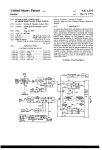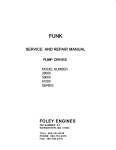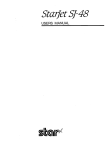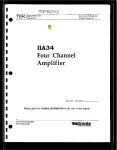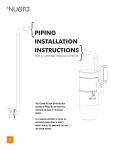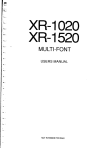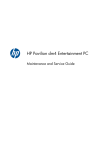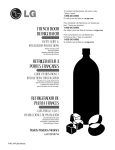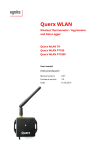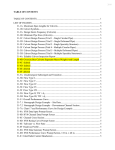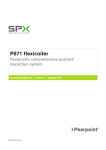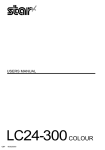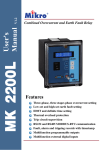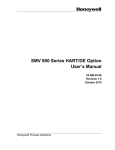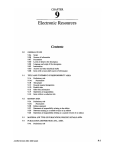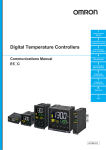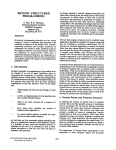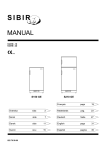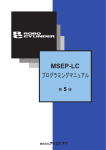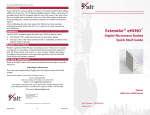Download XB24-200 XB24-250
Transcript
XB24-200 XB24-250 MULTI-FONT USERS MANUAL NOT INTENDED FOR SALE Self Declaration Radio interference regarding this equipment has been eliminated according to Vfg 1046/1984announced by the DBP. DBP has been informed of the introduction of this special equipment and has been granted the right to examine the whole series. It is the user’s responsibility to see that his own assembled system is in accordance with the technical regulations under Vfg 1046/1984. To conform to PlZ-regulations it is necessary to make all connections to the printer with shielded cable. ‘he equipment may only he opened by qualified service representatives. Tk above statement applies only to printers marketed in Germany. - - Trademark Acknowledgements XB24-2001250, XB24-10115, LC24-200, FZ24, LZ24, X24CL, RC-32Z, DC-32Z, IS-IIXL, IP-128XL, SF-lODMIl/lSDMII, SF-lORMII/l5RMII, PT.lOXM115XM: Star Micronics Co., Ltd. IBM-PC, PS/2, PC-AT, Proprinter X24E/XL24E, Proprinter X24fXL24, PC-DOS: International Business Machines Corp. MS-DOS, Microsoft BASIC: Microsoft Corporation LQ-S6U10609 LQ-850/1050: Seiko Epson Corp. - NOTICE l All rights reserved. Reproduction of any part of this manual in any form whatsoever without STAR’s express~rmissicn is forbidden. l The contents of IS manual are subject to change without notice. l Allefforts havebeenmadetoensuretheaccuracyofthecontentsofthismanualatIhetimeofpress. However, should any errors be detected, STAR would greatly appreciate being informed of them. l ‘lhe above notwithstanding, STAR can assume no responsibility for any errors in this manual. 0 Copyright 1991 Star Micronics Co., Ltd. - HQW TO USE THIS MANUAL This manual is organized into eleven chapters. To learn how to make the best use of your printer you am urged to mad through chapters 2 through 6. The remaining chapters may be treated as a reference guide for programming operations, etc. It assumes a degree of acknowledge of the operation of computers (for instance, it assumes you.know about hexadecimal numbers). The chapters are as follows: c.. Chapter 1 c ..- Introduction This chapter indicates the some features of the printer, the names and those functions of the printer components, and the actual example of font style. Chapter 2 - Setting up the printer This chapter explains how to get the printer unpacked and set up. Read this chapter before you do anything else. Chapter 3 - Optional accessories This chapter explains the optional accessories with your printer, and how to install them. Chapter 4 - Paper installation and use This chapter describes instructions for printing such as selecting paper types, adjusting the printing gap, and installing paper. Chapter 5 - Control panel operations There am a number of contmls on the front panel which perform various functions related to paper handling, print modes and font selection. After getting set up, read this chapter and try out the procedures in it to find out how the printer works. Chapter 6 - Default settings This chapter explains how to set the Electronic DIP Switch (EDS) mode to make system settings on the printer. Chapter 7 - Printer control commands This chapter explains the different emulations provided by your printer, and the software commands used to drive it. This section is of use if you are writing or modifying programs to take advantage of the printer’s features. Chapter 8 - Download characters This chapter explains the procedures to create your own characters. Chapter 9 - MS-DOS and your printer Since the PSL? or PC-AT family of computers running under MS-DOS is currently the most popular configuration of microcomputer, we have included a few hints and tips to help you use your printer with such systems. Since virtually all PCs are sold with a Microsoft BASIC interpreter, we have alsoincludedsomehints,andasampleprogmminthislanguagetodemonstrate the capabilities of the printer. Chapter 10 - Troubleshooting and maintenance This section gives a checklist of points to check if your printer is not working in the expected way. It also includes details of some routine maintenance operations you can carry out yourself. It is not, however, a complete service manual. Call a qualified service engineer if you am unsure of your ability to carry out any maintenance or servicing operations. Chapter 11 - Reference This section gives some reference of your printer, such as specifications of your primer, the pinout of interface connector, the character tables. The character table charts give the different character sets available. - - TABLE OF CONTENTS Chapter 1 INTRODUCTION Features of the printer Font style example Printer components Chapter 2 SETTING UP THE PRINTER Locating the printer Unpacking and inspection Setting up Mounting the platen knob Install the ribbon cartridge Connecting the interface cable Chapter 3 OPTIONAL ACCESSORIES Automatic Sheet Feeder Single-bin Automatic Sheet Feeder Dual-bin Automatic Sheet Feeder Pull Tractor Unit Font Cartridges and RAM Cartridges Interface Cartridges Chapter 4 PAPER INSTALLATION AND USE Selection of paper Adjusting the printing gap Loading fanfold forms Loading the paper from the rear of the printer Loading the paper from the bottom of the printer Loading the paper with Push/Pull feed Paper parking Paper unparking Loading single sheets Loading the paper without optional accessories Loading the paper with optional Automatic Sheet Feeder 7 7 8 10 10 11 12 15 15 15 20 22 23 25 27 27 28 29 30 32 33 36 37 38 38 40 Chapter 5 CONTROL PANEL OPERATIONS Bottoms and indicators ON LINE button PAPER FEED button SET/EJECT/PARK button PITCH button FONT button Power-up functions Short test mode Long test mode Print area test mode Pitch lock mode Font lock mode Font and Pitch lock mode Hexadecimal dump Switch combination functions Form feed Top of form Forward micro-feed Reverse micro-feed Changing the auto loading value Clearing the buffer/All reset Selecting the print color Selecting the ASF bin number Store macro definition Chapter 6 DEFAULT SETTINGS How to set the EDS mode Functions of the EDS settings Command parameters Font parameters Character parameters Style parameters Layout parameters Forms parameters Other parameters Dot Adjustment mode 43 43 44 44 45 45 46 47 47 48 49 49 49 49 50 52 52 52 53 53 53 54 54 55 56 - _- - 57 57 58 60 61 63 65 66 68 70 71 v Chapter 7 PRINTER CONTROL COMMANDS Font control commands Character set commands Character size and pitch commands Vertical position commands Horizontal position commands Graphics commands Download character commands Color selection commands Other printer commands Chapter 8 DOWNLOAD CHARACTERS Defining your own characters with Standard mode Assigning the character data Assigning a value of character space Sample program Defining your own characters with IBM mode Assigning the download character set Assigning the character dot pattern Assigning the Index Table data Sample program Chapter 9 MS-DOS AND YOUR PRINTER !nstalling application software with your printer Embedding printer commands Programming the printer with DOS commands Programming with BASIC Chapter lOTROUBLESHOOTING AND MAINTENANCE Troubleshooting Power supply Printing Paper feeding Maintenance Replacing the print head 73 74 81 84 90 97 103 107 112 113 117 117 118 119 120 122 122 123 125 126 129 129 130 132 135 143 143 144 144 146 149 149 Chapter 11 REFERENCE Specifications Pinout of interface connector Parallel interface Serial interface charactersets !3tandardcbaracterset#2 International charactex sets IBM character set #2 Character set#l IBM special character set Proportional spacing table 151 151 155 155 156 157 158 160 161 168 INDEX 183 COMMAND SUMMARY 187 169 170 - Chapter 1 lNTRODUCT/ON This printer has a full complement of features, making it an excellent partner for a personal computer. It supports the Epson/IBM printer commands and character sets, enabling it to print just about anything your computer can generate, both text and graphics. c L L - FEATURES OF THE PRINTER Some of main features are the following: l l l L. .. Versatile paper handling Single sheets, fanfold forms, and multi-part forms (up to 5-ply) are all accepted, andyoucanuseeitherpush/pulltractororfrictionfeed. (Youcan load fanfold forms from the rear with internal push tractor, or fanfold forms and multi-part forms from the bottom with optional pull tractor.) A special feature enables you to keep fanfold forms parked in readiness while printing on other paper. Six bright colors Magenta, cyan, violet, yellow, orange and green add a color dimension to your printed output by the optional color ribbon. Large variety of fonts The printer has the following resident fonts: High-Speed Draft Draft Sanserif Courier Orator ’ script SLQ TW-Light SLQ Roman l l l l l l l l l l Roman Prestige H-Gothic In addition, following fonts can be used by installing the optional font cartridge: L [FC- 1Z Cartridge] Orator 2 . Cinema l L. l Letter Gothic l Blippo 1 [FC-2Z Cartridge] OCR-B UPC/EAN l l OCR-A l Orane l Firenze l CODE 39 l [FC-3Z Cartridge] TW-Light l [FC-4Z Cartridge] Russian l [FC-SZ Cartridge] Old Style l [FC- 1OZCartridge] SLQ Script - Extensive software support Since it is compatible with the Epson and IBM printers, it works with any software that supports those printers. That includes most word-processing and graphics programs, spread-sheets, and integrated software packages. - l l l l - Easy operation Indicator displays and beep tones provide immediate, easy to understand feedback when you press the buttons on the control panel. The five buttons can operate in combinations to perform a surprising variety of functions, including micro-alignment. Easy care and maintenance The ribbon cartridge can be replaced in seconds the print head in a few minutes. -. FONT STYLE EXAMPLE yourprintercanprint. Thefollowingexampleshowsthemanyfontstyles b‘. .- Draft HS-Draft Roman Sanserif Courier Prestige Script OCR-B OCR-A Orator Orator-2 TW-Light Letter Gothic Blippo H-Gothic Orane Cinema CODE 39 LJPC/EAN Old Style Firenze SLQ Roman SLQ TW-Light SLQ Script 'I23456789 ABCDEFGHIJK 1234.55’7@3 1”g/y i j I<,, f>B[z[:l E Fc[;I-/ 1:J t< &)t:,::~:-Jty: abcdefghijk 123456789 ABCDEFGHIJK abcdefghijk 123456789 ABCDEFGHIJK abcdefghijk 123456789 ABCDEFGHIJK abcdefghijk 123456789 ABCDEFGHIJK abcdefghijk 1234567&g ABCDEFGHIJK abcd&gWk 123456789 ABCDEFGHIJK abcdefghijk 123456789 ABCDEFGHIJK abcdefghijk 123456789 ABCDEFGHIJK ABCDEFGHIJK 123456789 ABCDEFGHIJK abcdefshijk 123456789 ABCDEFGHIJK abcdefghijk 123456789 ABCDEFGHIJK abcdefghijk 123456789 ABCDEFGHIJK abcdefghijk 123456789 ABCDEFGHIJK abcdefghijk 123456789 A8CDEFGHlJK abcdefghijk 123456789 ABCDEFGHIJK abcdefghijk II11111111111111111111111111111111 Ml111111111111 Hill11111111111111 II ‘23456789 ~*34~6’891l11 11111 1111111 I III 111111 123456789 A3tl%EWQ~JJ~ abcbafghtfk 123456389 ABCDEfGliI~K abcdePyhijk 123456789 ABCDEFGHIJK abcdefghijk 123456789 ABCDEFGHIJK abcdefghijk 123456789 ABCDEFGHIJK abcde&h.i& PRINTER COMPONENTS To get acquainted with the printer’s components and capabilities, refer to the information on the following pages. Tractor Adjustment ,er guide lever - Control panel Tear assist Interface connector - Paper guide Release lever Front cover Rear cover Entry slot Tear assist Control panel Power switch Platen knob Interface connector Cartridge slot Print head Ribbon cartridge Adjustment lever Tractors Clamp lever Bail lever Aligns single sheets (cut forms) to help the printer detect when paper is inserted. Releases pressure on the paper. This lever must be back for fanfold forms, and forward for single sheets. Protects the print head and other internal components of your printer. Protects the tractor feed unit and separates incoming and outgoing fanfold forms. For inserting single sheets of paper. Assists when tearing fanfold forms at the perforation. CAUTION: Since the tear assist edge is made sharp to cut off paper, you must swing down the transparent part when you open the front cover. Otherwise, you may injure your fingers. Indicates printer status and makes various control of printer functions simple and convenient. Switches power on or off. Advances the paper manually. Connects the computer to the printer. Holds the optional Font cartridge or RAM cartridge. Has a dot matrix (24-wire) composition. Contains the printer ribbon. Controls print darkness by adjusting for the thickness of forms being printed. Control the movement of fanfold forms. Clamps the tractor in place. Opens and closes the paper bail which holds the paper against the platen. 5 MEMO - - V - - chapter 2 SETTING UP THE PRINTER This chapter describes the following procedures to set up your new printer. L. If you have optional accessories, refer to chapter 3 after setting up the printer. l Locating the printer l Unpacking the carton box l Mounting the platen knob l Installing the ribbon cartridge * Connecting the printer to your computer LOCATING THE PRINTER Before you start unpacking and setting up your printer, make sure that you have a suitable place on which to locate it. By “a suitable place”, we mean: . A firm, level surface which is fairly vibration-free l Away from excessive heat (such as direct sunlight, heaters, etc) l Away from excessive humidity 9 Away from excessive dust L... l l l l l Supply it with “clean” electricity. Do not connect it to the same circuit as a large, noise-producing appliance such as a refrigerator. Make sure the line voltage is the voltage specified on the printer’s identification plate. To disconnect the printer, the plug has to be disconnected from the wall socket, which has to be located close to the printer, and easy to access. Install the printer where there is sufficient mom for the paper and any paper being fed in or printed out. If you are connecting your printer with a parallel interface, make sure that the cable is within 2m (6ft) of the printer. AnRS-232 connectionusing the optional IS-8XL interface cartridge can be made over longer distances. 7 UNPACKING AND INSPECTION Now unpack the contents of the shipping carton, and check each item in the box against Figure 2- 1 to make sure that you have everything (there should be five items). If any of these items are missing, contact your supplier. - - - V F@uui&r. Check to make sure you have all five items: 1) Printer, 2) Paper guide, 3) Platen knob, 4) Ribbon cartridge, and 5) User’s manual. NOTE : The platen knob is mounted on the printer for the Normal carriage minter. 8 The optional accessories which you may have ordered with your printer are: . Film ribbon ctidge (FZ24) l Color ribbon cartridge (X24CL) l Font cartridges (FC series) l RAM cartridge (RC-32Z, DC-32Z) l Serial interface cartridge (IS-8XL) l Buffered parallel interface cartridge (IP- 128XL) l Automatic sheet feeder (SF-lODMII/lSDMII, SF-1ORMII/15FUvlII) . PuIl tractor unit (PT-lOXM/lSXM) For details of the optional accessories, refer to Chapter 3. 9 SETTING UP Place the printer in the desired location, and remove all packing material from inside the printer cover. This packing material is intended to prevent damage to the printer while in transit. You will want to keep all the packing material, along with the printer carton, in case you have to move the printer to a new location. - - Mounting the platen knob The platen knob is packed into an accessory box with other accessories for the Wide carriage printer. NOTE : For the Normal carriage printer, the platen knob is mounted on the printer at factory. - Mount the knob on the platen shaft, which is located on the right-hand side of the printer. Rotate the knob on the shaft before pushing the knob fully into position. - - - - “bd Platen knob - F/gwv 2-Z Mount the platen knob. - - 10 - Install the ribbon cartridge Open the front cover by lifting up the back using the two grips on either side, then swing down the transparent part (see Figure 2-3). F/gum 2-3. Open the front cover, and swing down the transparent part. Now install the ribbon with the following procedure. (If you want to print with color, install the optional color ribbon cartridge, X24CL.) 1. Turn the tension knob clockwise on the ribbon cartridge to tighten the ribbon if it is slack. 2. Guide the ribbon between the print head and the silver print head shield, making certain that the spindles on the cartridge holder fit into the sockets on the cartridge itself. The ribbon should pass between the print head and the print head shield as shown in Figure 24. 11 Ribbon canridee Print head \- Print head shield / - Figufe Z-4. Installing the ribbon cartridge. After you have installed the ribbon cartridge, close the front cover. Leave the front cover closed during normal operation. The cover keeps out dust and dirt and reduces the printer’s operating sounds. Open the cover only to change the ribbon or make an adjustment. Connecting the interface cab/e Connect the printer to your computer using a standard Centronics parallel interface cable. On a PS/2 or PC/AT-type computer, this means that you use the 25pin D-type connector at the computerend, and the Amphenol-type 36pin connector at the printer end. The configuration of the printer’s connector is given in Chapter 11 should you need a cable for connecting to another computer. ‘v If you need to connect to a serial port, use the optional Serial RS-232 interface cartridge, IS-8XL. Follow the procedures below to connect the interface cable: 1. Turn off the power switch both the printer and the computer. 2. Connect the interface cable to the printer as shown in Figure 2-5. Make sure that you press the plug fully into the interface connector. 12 - Inierface cable Fipu Z-5 Connectingthe interface cable. 3. Move both clips inside the extended prongs on the sides of the plug until you hear a click. Flguru Z-6. Move the clips until you hear a did. 4. Connect the other end of the interface cable to your computer. Use your computer instructions to attach the interface cable. NOTE :Because you need your computer when you start printing, ensure that it is completely installed. Plug the printer into a suitable outlet. However, DO NOT turn on the power switch at the front of the printer yet. NOTE:To disconnect the printer the plug has to be disconnected from the wall socket, which has to be located close to the printer, and easy to access. 13 MEMO - - V - chapter 3 OPTIONAL ACCESSORIES You can select the following accessories as option. l Automatic sheet feeder (SF-lODMII/lSDMIJ, SF-lORMW15RMII) l Pull tractor unit (BT-lOxM/lSXM) l Font cartridges (FC series) l RAM cartridge (RC-322, DC-322) l Serial interface cartridge (IS-8XL) l Buffered parallel interface cartridge (P-128XL) This chapter describes how to install these optional accessories. NOTE : When you install or remove the optional accessories, turn off the power switch. AUTOMATIC SHEET FEEDER You can use the Automatic Sheet Feeder to print on single sheets. This printer can be used either a Single-bin type or Dual-bin type Automatic Sheet Feeder. Single-Bin Automatic Sheet Feeder (SF- 1ODMIUI 5DM.u) The procedure to mount the Single-Bin ASF is: 1. Open the front cover by lifting up the back using the two grips on either side, then swing down the transparent part (see Figure 3-l). 2. Open the rear cover by lifting up the front using the two grips on either side, then remove it upward. If the paper guide is installed, remove it before taking off the rear cover. 3. Move the bail lever on top of the printer forward to open the paper bail. 15 Transparent part 4. A stacker is included with the Automatic Sheet Feeder. Attach the hook at the top of the stacker to the Automatic Sheet Feeder. Then push the lower section of the stacker down into position, and engage the lower hook as shown in Figure 3-3. 16 QumSZAttachthestadwtothaAutomaticSheetFesder. 5. Tip the Automatic Sheet Feeder forward slightly and put the feeder into place behind the printer platen roller. 6. Lower the rear side of the Automatic Sheet Feeder and attach it to the platen shaft. Automatic Sheet Feeder - 7. Close the front cover with the transparent part in the open position. - -I - 8. Insert the hopper attachment by hand into the holders on top of the hopper support section as shown in Figure 3-6. attachment 18 9. Squeeze the sides of the stacker attachments lightly, and insert into the holders on the front part of the sheet feeder. Stacker F/gufw *7. Insert the st8cker attachment. Now, you can use the ASF by installing the paper stack into the hopper. (Refer to Chapter 4.) In addition, you can feed a sheet of paper manually by inserting into the slot at the front of ASF roller as shown in Figure 3-8. Figwu 36 insert a sheet of paper to feed manually. NOTE : Set the paper guide and rear cover aside carefully after they have been removed from the printer. Reverse the procedure described above when removing the Automatic Sheet Feeder. 19 Dual-Bin Automatic Sheet Feeder (SF- I ORMIUISRMII) The procedure to mount the Dual-Bin ASF is: 1. Open the front cover by lifting up the back using the two grips on either side, then swing down the transparent part (see Figure 3-l). 2. Open the rear cover by lifting up the front using the two grips on either side, then remove it upward. If the paper guide is installed, remove it before taking off the rear cover. 3. Move the bail lever on top of the printer forward to open the paper bail. 4. A stacker is included with the Automatic Sheet Feeder. Attach the hook at the top of the stacker to the Automatic Sheet Feeder. Then push the lower section of the stacker down into position, and engage the lower hook as shown in Figure 3-9. - Figure 3-9. Attach the stacker to the Automatic Sheet Feeder. 5. Tip the Automatic Sheet Feeder forward slightly and put the feeder into place behind the printer platen roller. 6. Lower the rear side of the Automatic Sheet Feeder and attach it to the platen shaft. 7. Close the front cover with the transparent part in the open position. 8. Attach the clear plastic paper supports between the left and right paper guides of the hopper bins and the stacker. Figure310. Attach the dear plastic paper supports to the Automatic Sheet Feeder. Now, you can use the ASF by installing the paper stack into the bin. (Refer to Chapter 4.) In addition, you can feed a sheet of paper manually by inserting into the slot at the front of ASF bin #l as shown in Figure 3-l 1. Figure 311. You can insert a sheet of paper to th+ font slot. NOTE : Set the paper guide and rear cover aside carefully after they have been removed from the printer. Reverse the procedure described above when removing the Automatic Sheet Feeder. 21 PULL TRACTOR UNIT (PT-1 OXM/15XM) You can use the Pull Tractor Unit to print on fanfold forms or multi-part forms. The procedure to mount the FWl Tractor Unit is: 1. Open the front cover by lifting up the back using the two grips on either side, then swing down the transparent part (see Figure 3-l). 2. Open the rear cover by lifting up the front using the two grips on either side, then remove it upward. If the paper guide is installed, remove it before taking off the rear cover. 3. Move the bail lever on top of the printer forward to open the paper bail. 4. Squeeze the sides of the paper supports lightly, and insert into the holes on both side of the F%llTractor Unit as shown in Figure 3- 12. - - V Hgum 3-12. Mount the paper support A and B onto the Pull Tractor Unit. 5. Fit the mounting brackets of the pull Tractor Unit onto the shaft of the printer mechanism, tilting the Pull Tractor Unit slightly backward. 6. Secure the FW Tractor Unit firmly by lowering it into position, as shown in Figure 3- 13. 7. Close the front cover with the transparent part in the open position. -. - 22 I Figure 3-13. Mount the Pull Tractor Unit onto the printer. NOTE : Set the paper guide and rear cover aside carefully after they have been removed from the printer. Reverse the procedure described above when removing the Pull Tractor Unit. FONT CARTRIDGES AND RAM CARTRIDGES This printer has seven built-in LQ fonts, and a 29 K-byte (76 K-byte for wide carriage type printer) printing buffer. You can add the following optional fonts or expand the printing buffer by installing optional cartridges (Font Cartridge or RAM Cartridge). [FC- 1Z Cartridge] Orator 2 Cinema l Letter Gothic l Blippo [FC-2Z Cartridge] OCR-B UPC/EAN l OCR-A l CODE 39 l Orane l l l l [FC-3Z Cartridge] TW-Light l 23 [FC4Z Cartridge] Russian l [FC-SZ Cartridge] Old Style l l Firenze [FC- 1OZCartridge] SLQ Script l To install or change a cartridge, follow the procedure below. 1. Turn off the power switch at the front of the printer, and open the front cover. Swing down the transparent part (see Figure 3-l). 2. Remove the connector cover at the right side of the printer. 3. Rush out the cap from the connector cover. NOTE:Keep this cap in a safe place. ._ Cartridge cover - Y Flgurr 514. Slide the cartridge intO the sbt with the power switch off. 4. Install the connector cover into the printer. 5. Insert the cartridge into the slot of the connector cover, and slide it all the way in. NOTE:Remount the cap on the connector cover if you do not use the optional cartridge. 24 INTERFACE CARTRIDGES You can use the Serial RS-232 Interface with the optional Serial Interface Cartridge (ISgXL), or extend the print buffer by installing the optional Buffered ParaIlel Interface Cartridge (IP-128XL), instead of the Standard Interface Cartridge. If you want to use the Serial Interface Cartridge, set the DIP switches on the board before instalI it to the printer. 1. Turn off the power switch and disconnect the power cord from the power soufce. 2. Disconnect the interface cable if attached. 3. Compress the projected parts on the right and left, and pull the Standard Interface Cartridge to remove it from the printer. Figum 315. Remove the Standard Interface Cartridge from the printer. 4. Insert the optional Interface Cartridge securely into place. If it is not fuIIy inserted, the printer will not properly print. 5. Connect the interface cable to the connector. NOTE: Store the removed Interface Cartridge in a safe place. 25 DIP Switch Functions on The Serial Interface Cartridge It is necessary to make compatible the data transfer conditions between the computer and the serial interface board with the DIP switch settings on the serial interface board. Following table shows the functions of the DIP switches on the Serial Interface Cartridge. H [Parity condition] switch 1 Data length Parity condition (Refer below) I Data Protocol (Refer below) Parity condition CReferbelow) I 1Switch 2 1Switch 5 ( Condition @efer below) LDatapro tocol] I I 1 Switch 3 Switch 4 Protocol I ON DTR ON XON/XOFF ON OFF ETX/ACK OFF ON [Transfer speed] Transfer speed 26 chapter 4 PAPER INSTALLATIONAND USE This chapter describes instructions forprinting such as selecting paper types, adjusting the printing gap, and installing paper. SELECTION OF PAPER .L Your printer accepts any of the following papers: l l l Single sheets (cut forms) and stationary Use the friction feed or the optional Automatic Sheet Feeder. Fanfold forms Fanfold forms have holes along the sides and perforations between the sheets. They are also called sprocket forms, punched forms, or just plain “computer paper”. Printing on or near the perforations of continuous fanfold forms may reduce printing quality, misalign the fanfold forms, or cause a paper jam. It is recommended not to print within an area of one inch before and after the perforations. Multi-part forms You can use multi-part forms that have up to five parts including the original when the Multi-part mode is selected with the EDS setting. (For details, please refer to Chapter 6.) Use pressure sensitive multi-part forms with both side edges glued and a difference in thickness of 0.05mm or less between the side edges. It is recommended to use the bottom feed with the optional Pull Tractor Unit to get fine alignment. NOTE : Care should be taken in color printing with continuous multi-part forms. Side edges of paper might be damaged. i-. l Preprinted forms 27 Figure 4-l shows the recommended print area for each type of papers. Single sheets Fanfold forma 1 - (*X0 mm for Push Feed) Figum CT. Racornmandad print area for acceptable papwa. ADJUSTING THE PRINTING GAP The distance between the print head and the platen can be adjusted to accommodate different paperthicknesses. To make this adjustment, open the front cover. The adjustment lever is located at the left side of the printer mechanism. Pushing the adjustment lever backwards narrows the gap; pulling it forwards widens the gap. There are seven positions, and you can feel the lever clicking into each position. The second position from the rear (marked with “9”) is the one most commonly used for single sheets of paper. Try different positions until you get the best printing results. NOTE : Printing with an inappropriate gap may drastically shorten the life of the print head. 28 - -~ I - Ad,justment lever F@m 4-2 Location of the adjustment lever. The following table provides the recommended lever positions for each paper types as a reference. 40-58 0.18 - 0.25 3rd or 4th 40-58 0.24 - 0.30 4th or 5th 40-58 0.30 - 0.35 5th or 6th LOADING FANFOLD FORMS This printer accepts fanfold forms up to 10” wide for the normal carriage printer, and up to 16” wide for the wide carriage printer. You can load fanfold paper with the following three ways: Push feed with internal tractor unit Bottom feed with optional Fkll Tractor Unit Push/Pull feed with internal tractor unit and the optional Pull Tractor Unit. l l l This section will take you through the procedures for loading, parking and unparking fanfold forms. - Loading the paper from the rear of the printer (Push feed) You can load the fanfold paper with the internal push tractor unit. 1. Place a stack of fanfold paper behind and at least one page-length below the printer. 2. Turn the printer’s power OFF. 3. Push the mleaseleverbackward. This has the effect of releasing the paper from the platen roller, and engaging the tractor feed. 4. Remove the paper guide and put it aside for the moment. 5. Open the transparent part of the front cover, and the rear cover using the two grips on either side, as in Figure 4-3. - Release lever Rear cover - - Figurn 4-3 Opening the rear cover. 6. Pass the paper between the printer case and the rear cover. 7. With the tractor covers open, mount the paper by aligning holes with the pins on the tractor unit. 8. Adjust the spacing of the tractor units by sliding them along the bar, using the clamp lever at the back of each unit to release and lock them in position. When the clamp lever is up, the unit is released, and when it is down, the unit is locked. 30 Tractor cover Figun Clamp lever 4-4. Mount the fanfold paper over the tractor units. 9. Now close the tractor covers, again making sure that the paper holes are aligned with the pins on the tractor units. If they are not aligned properly, you will have problems with paper feeding, possibly resulting in tearing and jamming of the paper. 10. Turn on the power using the switch located at the front of the printer. The printer will beep, indicating that the paper is not yet fully loaded. The “PAPER OUT” message will also flash to confirm this. 11. Now press the [ 8t,Z&PT I button. The paper will be fed and adjusted past the print head to a position ready for printing. 12. If you want to set the paper to a different position, set the printer off-line by pressing the I ON LINE 1 button, then set the paper by using the micro-feed function. (For details, refer to Chapter 5.) 13. Close the rear cover and the transparent part of the front cover, then mount the paper guide in the horizontal position shown in Figure 4-5, so that it will separate the printed from the unprinted paper. 31 FcgUrr 4-5. Mounting the paper guide for fanfold forms. Loading the paper from the bottom of the printer You can load the fanfold paper from the bottom of the printer with the optional Pull Tractor Unit. 1. Install the optional Pull Tractor Unit as described in Chapter 3. - - F/gum 4-6. Install the optional Pull Tractor Unit. 32 - 2. With the tractor covers open, mount the paper from the bottom of the printer, by aligning holes with the pins on the tractor unit. fVgum 47. Mount the fanfold paper from the bottum of the printer. 3. Adjust the spacing of the tractor units by sliding them along the bar, using the clamp lever at the back of each unit to release and lock them in position. When the lever is up, the unit is released, and when it is down, the unit is locked. 4. Now close the tractor covets, again making sure that the paper holes are aligned with the pins on the tractor units. If they are not aligned properly, you will have problems with paper feeding, possibly resulting in tearing and jamming of the paper. Loading the paper with Push/pull feed You can load the fanfold paper with Push/Pull feed by using both the internal push tractor unit and the optional Pull Tractor Unit. 1. Place a stack of fanfold paper behind and at least one page-length below the printer. 2. Turn the printer’s power OFF. 3. Push the releaseleverbackward. This has the effect of releasing the paper from the platen roller, and engaging the tractor feed. 33 - 4. Open the transparent part of the front cover, and remove the paper guide and the rear cover. 5. With the tractor covers open, mount the paper by aligning holes with the pins on the tractor unit. 6. Adjust the spacing of the tractor units by sliding them along the bar, using the clamp lever at the back of each unit to release and lock them in position. When the clamp lever is up, the unit is released, and when it is down, the unit is locked. 7. Now close the tractor covers, again making sum that the paper holes are aligned with the pins on the tractor units. If they am not aligned properly, you will have problems with paper feeding, possibly resulting in tearing and jamming of the paper. - - Release lever Figum &I Mount the fanfold paper over be internal tractor units. 8. Turn on the power using the switch located at the front of the printer. The printer will beep, indicating that the paper is not yet fully loaded. The “PAPER OUT” message will also flash to confirm this. 9. Now press the lBt,%!SEo ’7 button. The paper will be fed past the print head. 10. Turn off the power, and install the optional Pull Tractor Unit as described in Chapter 3. 11. With the optional tractor covers open, turn the platen knob clockwise to mount the paper by aligning holes with the pins on the optional tractor unit. 34 - Clamp lever ractor cover Flgwv +o. Mount the hfold paper to the Pull Trader Unit by turning the platen knob. 12. Adjust the spacing of the optional tractor units by sliding them along the bar, using the clamp lever at the back of each unit to release and lock them in position. When the lever is up, the unit is released, and when it is down, the unit is locked. 13. Now close the tractor covers, again making sure that the paper holes are aligned with the pins on the optional tractor units. If they are not aligned properly, you will have problems with paper feeding, possibly resulting in tearing and jamming of the paper. 14. Remove the lever stopper from the slot of the release lever as shown in Flgure 4-10. 15. Set the release lever to the ‘Q” position, and turn the platen knob clockwise to tighten the paper if it is slack. 35 Lever stopper Platen knob Figum d-70. Remove the lever stopper, and tighten the paper. 16. Push the release lever backward, and remount the lever stopper to the original position. Paper parking After loading fanfold paper with Push feed mode, you do not have to unload it when you want to print on a single sheet. The printer will “park” it for you if you follow the procedure below. 1. To begin paper parking, start with power ON, fanfold paper loaded in printing position, and the release lever backward. 2. Press the [ ON LINE 1 button on the control panel to set the printer offline. ON LINE indicator will turn off. 3. Tear off the printed fonn at the last perforation, leaving not more than about half a page showing above the front cover. If necessary, press the 1 PAPER FEED 1 button to feed paper forward until a perforation is located just above the front cover, and tear there. 4. Press the P’ “%PGrl button on the control panel. The printer w~au~matically feed the fanfold fonn backward until the paper is completely free of the platen. 5. Move the release lever to the front. 36 V - - Release lever aper guide F/gum 4-71. Tear off the printed fanfotd paper. 6. Mount the paper guide in the upright position. Now you canload single sheets. The fanfold paper remains parked at the back of the printer. NOTE : You cannot park the fanfold paper if you have loaded it using the optional Pull Tractor Unit. Paper unparking When you want to resume using fanfold paper, the procedure is as follows. 1 2. 3. 4. Remove all single sheets from the printer. Mount the paper guide in the horizontal position. Move the release lever to the backward. Press the I?=“‘1 button. The printer will automatically feed the parked fanfold paper back into position for printing. NOTE : The printer beeps intermittently if you move the release lever while the paper is loaded. 37 LOADING SINGLE SHEETS This section will take you through the procedures for loading single sheets of paper. Loading the paper without optional accessories If you are using the optional Automatic Sheet Feeder, refer to next section. 1. Place the paper guide in position by inserting the tabs, located on the bottom of the assembly, into the slots on the rear cover of the printer. - Paper guide - F/gum 4-72 Mounti~ the paper guide for single sheets. 2. Adjust the paper guides to match the size of the paper you will be using. Remember that printing will start some distance from the left-hand edge of the carriage. 3. Turn on the power using the switch located at the front of the printer. The printer will beep, indicating that there is no paper in position for printing. The “PAPER OUT message will also flash to confirm this. 4. Make sure that the release lever is at front position. If fanfold paper is already mounted in the printer, press the I”‘?ZZE’T button to park the paper in the off-line state, then move the release lever forward. - - - 5. Place a single sheet between the guides, placing the side on which you want to print towards the back of the printer. Gently push the paper down in the guides until you feel it stop. button. The paper will be fed into the 6. Now press the m] printer and adjusted past the print head to a position ready for printing. 7. If you want to set the paper to a different position, set the printer off-line by pressing the I ON LINE I button, then set the paper position by using the micro-feed function. (For details, refer to Chapter 5.) F/gum4-13.Loadinga singlesheet. - Loading the paper with optional Automatic Sheet Feeder If you are not using the optional Automatic Sheet Feeder, refer to the previous section. -- 1. Install the optional Automatic Sheet Feeder as described in Chapter 3. - - I F/gum411. Installtheoptional AutmaticSheetFeeder. 2. Use the printer’s EDS mode to select ASF. (For details, please refer to Chapter 6.) 3. If fanfold paper has already been loaded in the printer, park the paper through the rear slot. 4. Full the printer release lever forward to load single sheets. 5. When you am using Single-Bin ASF, pull the paper loading lever forward to pull the hopper out until it is in position. In case of the Dual-Bin ASF, pull both pressure bar levers forward to open the pressure bar. 40 - - Paper loading lever [Dual-Bin] lever [Single-Bin] f/gum 415. Make ready ID load paper. 6. Adjust the left paper guide to the desired left position by moving it horizontally in either dinxtion. (Unlock the paper guides by pressing down on the locking levers in case of Dual-Bin ASF.) 7. Lock the lefi paper guides in position by moving the locking lever up for the Dual-Bin ASF. Figwv 416. Adjust the paper guides to acammdata the width of the paper. 41 8. Adjust the right paper guide to accommodate the width of the paper. The guides should be adjusted to restrict the amount of horizontal play while allowing the paper to slide up and down freely between the two paper guides. The ideal distance between paper ream and paper guides is 0.25 mm (0.01”) on both sides at the narrowest part of the paper guides. 9. Fan the paper stack and square it off properly before inserting it into the Automatic Sheet Feeder. Flgun 417. FM the paper before inserting into the ASF. - 10. Insert the paper stack into the Automatic Sheet Feeder. The stack should not be more than 15 mm (5/V) equivalent to 150 sheets of 20 lb paper. If necessary, remove some sheets. The ASF may not perform satisfactorily if it is overloaded. 11. When you am using Single-Bin ASF, push the paper loading lever toward the back. In case of the Dual-Bin ASF, push both pressure bar levers toward the back to “FEED” .~ - - L Figurr 418. Push the paper loading lever or pressure bar levers to hold lhe paper stack. 42 - chapter 5 CONTROL PANEL OPERATIONS The control panel buttons can be pressed individually to perform the operations indicated by their names. Other functions can be achieved by holding these buttons down when you turn the printer’s power on, or by pressing the control panel buttons in combination. This chapter explains all the button and indicator functions. Pause printing Feed paper (fast and slow, forward and reverse) Park fanfold forms Set the top-of-form position Select the print pitch Select a font Print test patterns . Prevent software from changing the panel pitch and font selections Print a hexadecimal dump Clear the printer’s buffer Change the print color Store macro deftition l l l l l l l l l l l BUTTONS AND INDICATORS The printer is equipped with five buttons on the control panel. From left to 1, -),I PAPER FEED 1 righttheyare 1 MODE FO,,,T I, I PITCH and [ ON LINE 1. The following is a brief guide to the buttons and indicators on the control panel. Figure 5-I. Control panel. ON LINE button The 1 ON LINE 1 button sets the printer on-line and off-line. The status changes each time you press the button. When the printer is on-line, it can receive and print data from the computer. When the printer is off-line, it stops printing and sends the computer a signal indicating that it cannot accept data. The printer powers up in the on-line status if paper is loaded. If paper is not loaded, the printer powers up off-line with the “PAPER OUT” message blinking. When you load paper, the printer goes on-line. You will want to press the I l l . ON LINE ] button: Before and after any other panel operation The other panel buttons operate only in the off-line state. Press the [ ON LINE 1 button to go off-line. After performing the panel operation(s), press the I ON LINE 1 button again to go back on-line. To pause during printing If you press the I ON LINE 1 button during printing, the printer stops printing and goes off-line, allowing you to check the printout or change a control panel setting. Printing resumes when you press the I ON LINE I button again to go back on-line. To cut fanfold fonns at the end of printing When you hold the [ ON LINE 1 button down for one second with the push tractor mode, the printer goes off-line and displays the “SHORTTEAROFF” message, then the printer also feeds the paper forward apptoximately two inches forward. This allows you to cut it offjust below the last line printed. When you press the I ON LINE 1button again to go back on-line, the paper feeds backward stopping where you left off. NOTE: This function is valid only when the buffer is empty. PAPER FEED button If you press this button while off-line, the paper will feed forward. If you hold the button down, the printer will perform consecutive line feeds. If you also press the 1 ON LINE 1 button while you are line-feeding, the paper will feed automatically to the top of the next page. This is explained later. 44 - _~ - - If you press this button while on-line, this will alternately flash the QUIET indicator. When in Quiet mode with the QUIET indicator lit, the printer will print slightly slower, but at a reduced noise level. SET/EJECT/PARK button NOTE :This button has no effect if the bottom feed mode is selected. Pressing this button causes the printer to begin paper loading if the paper has not loaded while in the off-line state. If the paper has been loaded, this button results in different functions depending on the position of the release lever. If the release lever is back for the fanfold forms, pressing this button parks the forms. If the release lever is forward for the single sheets, pressing this button ejects the paper. PITCH button This button allows you to select the printing pitch. Remember that the printer must be off-line for you to do this. Successive presses of this button will display (and select) the following options in order (Note that semi-condensed pitch and condensed proportional pitch are not available in the IBM mode): Message Pitch pica (1oCPI) Elite (12CF’I) Semi-condensed ( 1SCPI) Condensed pica (17CPI) Condensed elite(2OCPI) Proportional Condensed Proportional 10 12 15 17 20 PRO P.C 45 FONT button This button selects the font to he printed. Roman font is selected at powerup unless the default settings are changed. To change the font, set the printer off-line, then press the I YZ%Z I button repeatedly until the message on the display illuminates. The selections cycle in the following order: Font Message Font Message Roman Sanserif Courier Prestige Script OCR-B OCR-A ROMAN SANSERIF COURIER PRESTIGE SCRIPT H-Gothic Orate Cinema Bar code 39 UPCEAN Old Style Firenze SLQ Roman SLQ TW-light SLQ Script Draft High-SpeedDraft H-GOTHIC ORANE CINEMA Orator with small caps Orator with lower case TW-light Letter Gothic Blippo OCR-B OCR-A ORATOR ORATOR-2 TW-LIGHT L GOTHIC BLIPPO CODE 39 UPC/EAN 0 STYLE FIRENZE ROMAN SQ TW-LIGHT SQ SCRIPT SQ DRAFT HS-DRAFT -I If a Font cartridge is not installed, the selection of related Font is skipped. If you want to change the character quality quickly, press this MODtz FONT 1 button in on-line. The printer stops printing and enters the Quick mode, with “QUICK MODE” message on the display. If you continue to press the [ YE?,% ] button, the display changes to “HS-DRAFT”, “DRAFT” and LQ/SLQ (curretly-selected SLQ or LQ font) repeatedly. Printing will be performed according to the print mode message on the display which selected when the button is released. 46 -._ -- POWER-UP FUNCTIONS In addition to their normal functions, all the control panel buttons have special functions that operate if you hold them down while switching power on. Fnnr& Pitch luck F/gum 5-Z Power-up functions of mned panel. Short test mode Iftheprinteristumedonwhiiethe [ ON LINE 1buttonispressed,theprinter will enter the short self-test mode, with the “SELF TEST SHORT” message on the display. The printer will print the version number of the printer’s ROM, followed by seven lines of the character set. Each line will be offset by one character from the one before it. The final result will be something like Figure 5-3. (If the color ribbon is used, each line prints in a different color.) *** Ver x.x *** F/gum 53. Short self-test. Since the self-test occupies the full width of the carriage, it is recommended that the printer is loaded with the widest paper possible to avoid damage to the print head and/or platen. Long test mode I Iftheprinteristurnedonwhilethe [ PAPER FEED I buttonispressed,theprinter will enter the long self-test mode, with the “SELF TEST LONG” message on the display. The printer will print the version number of the printer’s ROM, the current EDS settings and the current Dot Adjustment setting, followed by the whole character set printed in each font and pitch available. The test cycles endlessly, so you must turn the power off to stop it. .- Figun, 5-4. Long self-test. 48 Since the self-test occupies the full width of the carriage, it is recommended that the printer is loaded with the widest paper possible to avoid damage to the print head and/or platen. In addition, the total number of lines printed is considerable, more than can be accommodated on a single sheet, so fanfold paper is recommended for this test. Print area test mode b. c. .- By holding the IsE~%Z-7 button down during power-up, the printer will enter the print area test mode. This way, you can find how many lines on your paperareavailableforprinting.Theprinterwillshowthe“SELFTESTTOP&B.” on the display and print the first line message, then print the last line message after feeding to the bottom of the page. If you have loaded the fanfold paper, only the first line message is printed. Pitch lock mode By holding the L button down during power-up, the print pitch can only be selected from the control panel. This prevents software interference. You will hear an acknowledging beep, and the printer will show the “PITCH LOCK” message on the display as power comes on. After the beep tone, you can set the printer off-line, select a print pitch, then return to on-line and start printing. The pitch you selected will show with “*” on the display and not be reset or otherwise changed by any commands your software may issue. Font lock mode c By holding the ~~~ 1 button during power-up, fonts can only be selected fmm the control panel. This prevents software interference. There will be an acknowledging beep and “FONT LOCK” message on the display. After which you can set the printer off-line, select a font, then Mum to the on-line state and begin printing. The selected font, shown with “**’on the display, will not be changed by any commands your software may issue. Font and Pitch lock mode If you want to protect both the pitch and font settings from software changes, and I PITCH 1 buttons during power-up. press both the -1 There will be two acknowledging beep tones and “FONT&PITCH LOCK” message on the display. Pressing these buttons during power-up does not prevent you from making any number of changes later from the control panel. 49 Hexadecimal dump This feature is useful for programmers who am debugging printing programs and want to see the actual codes the printer is receiving. (Some computers change the codes the programmer intended.) In this mode, all data received will be printed in a hexadecimal dump format, rather than the control codes being acted on as command codes. This mode is accessed with the following procedure: - 1. While holding both the I PAPER FEED I and IBt;.!ZFl buttons down, turn power ON. A beep tone will be head and the “HEX DUMP MODE” message on the display. 2. Begin printing. In place of the usual printout you will get a formatted dump showing exactly what data the printer receives. Each line presents sixteen characters, their hexadecimal codes to the left and printable characters printed on the right. 3. At the end of the hexadecimal dump, set the printer off-line with the 1 ON LINF I button. This is necessary to print the last line. The following BASIC program is a simple test you can run in hexadecimal mode: 10 20 30 40 50 60 WIDTH "LPT1:",255 FOR I=0 TO 255 LPRINT CHR$(I); NEXT I LPRINT END - - rin 31 D 03 04 05 06 07 08 09 OA OR OC OD OE OF 10 20 30 11 21 31 12 22 3: 1: 23 ., >i 14 24 14 15 25 55 16 26 36 17 27 37 18 28 38 19 29 39 1A ZA JA 1B ZB 38 IC ZC 32 ID 20 30 1E ZE 3E If 2F 3F '"u$%&'()*+./ ";2:4jfj789:...=.'! 40 50 60 41 51 El 42 5; 62 41 53 63 44 54 64 45 55 65 46 56 66 47 57 6? 48 58 68 49 59 69 4A 5A 6A 48 58 6B 4C 5C 6C 40 50 60 4E 5E 6E 4f 5f 6F @ABCDEFGHIJKLMNO t'i)H; iuvwxyz [ >,j abideigi,i ,I imr-,o 70 80 30 71 81 9i 72 82 Yi I? 83 93 74 84 94 75 7b 85 56 cl5 36 7i 87 97 78 88 98 79 89 Y9 7A 8A QA 78 8R 96 7C 8C 9C 70 80 90 7E 8E QE 7f 8f 9f pqrstuvwxy:C;j-. A0 BO Al Bl A2 62 A3 63 A4 64 A5 85 A6 BO A7 R;' A8 58 A9 B9 AA BA AK BR AC BC AD BD AE BE AF tiF i-0 do LO FO OD Cl Ul El Fl OA C2 02 EZ 12 C3 DA E3 F3 C4 u4 C5 05 Db 07 C8 08 C9 DY CA DA CR DB CC DC CD DD CE DE CF Uf E4 f4 E5 F5 E6 ;b i: Fi E8 i8 E9 F9 EA FA EB FB EC FC ED FD EE FE EF Ff Cb C7 F/gun rM Sample hexadecimal dump. - If your system passes the codes directly to the printer without changing them, you will get a printout like Figure 5-5. Most BASICS, however, are not quite that straightforward. For example, the IBM-PC will give you a printout similar to Figure 5-6. 00 01 OF 10 ;'O 21 02 -1 72 03 04 1,' 13 23 24 05 14 25 06 15 26 07 16 i; 30 no 50 Ii0 70 SO 90 31 4, 51 61 71 81 91 3: 47 52 62 72 62 92 33 4: 53 63 73 83 93 34 44 54 64 is 84 94 35 45 55 65 75 85 95 36 46 50 66 76 36 Y6 37 47 51 67 77 87 97 A0 50 Al 61 AZ BZ A3 83 A4 64 A5 55 A6 86 A7 57 1:0 DO t0 FO Cl 01 El Fl CZ DZ EZ F2 C3 D3 E3 F3 C4 D4 E4 F4 C5 05 ES F5 C6 00 E6 F6 C7 D7 E7 F7 00 OA 08 17 09 1E OA 19 OF: OC It3 1L OD IO Ok 1E Of 1F 28 29 ZA 78, ?C ZCI Zf 2F 38 39 3A 36 31: AD 3f 3F 48 58 68 78 88 98 A8 68 C8 D8 E8 F8 4y 59 69 79 89 99 A9 59 CY DY EY f9 4A SA 6A 7A SA 9A AA BA CA DA EA FA 48 56 6H 78 88 YB AR BH CK DR E5 FB 4C 5~ 6C 7C 8C 91: AC 40 5u 6D 70 8D YD AC! 4E 5E 6E 7E 8E 9E AE 4f 5F 6F 7F 8F 9F AF BC CC DC EC FC BD CD DO ED FD BE CE DE EE FE BF CF Df EF FF ................ ...... ......... ....... ........ ................ ................ Figurer !W. Sample hexadecimal dump with IBM-PC. When the IBM-PC BASIC interpreter sends hex code OD (carriage return) it adds an extra hex OA(line feed). Hex code 1A (end-of-file) also gets special treatment: the interpreter does not send it at all. This can cause problems with graphics or download character data. However, you can solve this problem by changing line 30 in the preceding program and adding the coding shown below. Coding for IBM-PC with monochrome display: 30 GOSUB 100 100 X=INP(&H3BD) 110 OUT &H3BC,I 120 RETURN :IF X(128 THEN 100 :OUT &H3BE,5 :OUT &H3BE,4 Coding for IBM-PC with color adapter: 30 GOSUB 100 100 X=INP(&H379) 110 OUT &H378,1 120 RETURN :IF X<128 THEN 100 :OUT &H37A,5 :OUT &H37A,4 51 SWITCH COMBINATION FUNCTIONS Several additional functions can be achieved by pressing the control panel buttons in combinations. - If you am using single sheets, this operation ejects the current page. If you are using fanfold forms, it feeds to the top of the next page. 1. Press the 1 ON LINE 1 button to set the printer off-line. 2. Press the I PAPER FEED I button and hold it down. The printer will start performing successive line feeds. 3. While holding the I PAPER FEED 1 button down, press the I ON LINE I button, then release both buttons at the same time. The printer will smoothly eject the current page. Top of form When you power on the printer, the top-of-form position is automatically set to the curmnt position. If this is not where you want the top of the page to be, you can change the top-of-form position as follows: 1. Press the 1 ON LINE 1 button to set the printer off-line. 2. Move the paper to the desired top-of-form position by pressing the I PAPER FEED I button, or by performing a forward or reverse micro-feed. 52 -. - 3. Press and hold the 1 ON LINE ) button. 4. While holding the I ON LINE I button down, press and the [ PtrCH 1 button, then release both buttons at the same time. The “SET TOF POSITION” message will show on the display to indicate that the top-of-form position has been set. Forward micro-feed For fine alignment, you can feed the paper forward in very small increments as follows: 1. Press the 1 ON LINE I button to set the printer off-line. 2. Press the 1 ON LINE 1 button again and hold it down. 3. While holding the I ON LINE 1 button down, press the 1 PAPER FEED ] button. The paper will start advancing in a series of small steps. When you want to stop, release both buttons. Reverse micro-feed You can also feed the paper in small increments in reverse, to return to a higher position on the same page. c c C. NOTE: With fanfold forms, do not try to return to a previous page. The perforation may catch inside the printer. 1. Press the 1 ON LINE 1 button to set the printer off-line. 2. Press the I ON LINE 1 button again and hold it down. 3. While holding the r ON LINE ] button down, press the a@=l’%?=G *1 button. The paper will start moving backwards in a series of sL$ s;eps. When you want to stop, release both buttons. Changing the auto loading value e I L a i F Normally, the printer automatically loads the paper one line from the top edge. If you want to change this value, follow this procedure: 1. Load the paper using the [atC&SG ’ I button. 2. Change the print position using the micro feed function. 3. After you get the desired position, press the 1 ON LINE 1 button to save the value. The “TOP MARGIN SET” message will show on the display. This value will remain unless you power off the printer. If you want to retain this value even after you turn off the power, store it using the Macro Definition function, which is described later. Note that you can only change this value immediately after loading paper. If you feed paper, you cannot change the auto loading value. Clearing the buffer/A/i reset The printer stores received data in a large memory buffer. This creates a problem when you want to abandon a printing job and restart: the printer may beholdingmoredatainitsbufferthanithasactuallyprinted,andthisunprinted data must be cleared out before restarting. Turning power off is one way to clear the buffer, but there is another way: 1. Halt the printing program on the computer. If printing stops immediately, the buffer is clear and the rest of this procedure is unnecessary. If printing does not stop, continue as follows: 2. Press the 1 ON LINE 1 button to set the printer off-line. Printing will now stop, but there may be data remaining in the buffer. 3. Press and hold the I ON LINE 1 button. 4. While pressing the I ON LINE 1 button down, press and hold the u MOOE button. Continue holding these two buttons down. In one second you will hear a beep tone and the “BUFFER CLEAR” message on display signaling that the buffer has been cleared. If you hold these buttons more three seconds, you will hear three beep tones and the “PRINTER RESET” message on the display signaling that the printer has been initialized to the power-on default settings. 5. Release these buttons, make any necessary control panel settings, then set the printer back on-line. Y It is essential to halt the printing program on the computer before you go offline. Otherwise, when you go back on-line the computer will start sending data again and the printer will continue printing, with missing data where the buffer was cleared. Selecting the print color Normally, the printer prints with black even if the color ribbon is installed. Without the aid of software, you can change the printing color as follows: 1. Press the ION 2. Press the I YES-F 54 button to set the printer off-line. I button and hold it down. - 3. While holding the I ?%ZZ I button, press the VZZGZGT I button. The “CURRENT BLAW’message will show on the display to indicate the current color setting. (In this case, the current color is set black.) 4. If you want to change the color, press the I”’ PA& r/b I=CTI button while holding the I ?-z%z~ ] button. The message on the display will be changed in the following order. Color Message CHANGE BLACK Black Magenta CHANGE MAGENTA cyan Violet CHANGE CYAN CHANGE VIOLET .Ei 5. Release both buttons after you set the desired printing color. If you want to save the selected colorforlater use, store it using the Macro Definition. NOTE : This function is valid only when the color ribbon is installed into the printer. Selecting the ASF bin number Youcanusethedual-bintypeAutomaticSheetFeeder(SF-1ORMII/15RMII) with this printer. You can select this ASF bin number by the control panel operation as shown below: 1. Press the I ON LINE 1 button to set the printer off-line. 2. Press the I ‘ZZGLJ button and hold it down. 3. While holding down the [ ?!‘o”,“,’ 1button, press the [ PAPER FEED I button. The “CURRENT ASF BINl” message (when ASF bin #1 is selected) will show on the display. 4. Each time you press the I PAPER FEED I button while holding down the MODtz FONT I button, the “CHANGE ASF BINl” and the “CHANGE ASF BIN2” message will be shown on the display. 5. Release both buttons after you set the desired ASF bin number. NOTE :This function is valid only when the Dual-bin ASF is selected by the EDS setting. 55 - Store Macro Definition You can store the current settings to the printer for later use with the following procedure: 1. Press the I ON LINE 1 button to set the printer off-line. 2. Press the Ibutton and hold it down. PITCH button down, press the I I 3. While holding the m button and hold them down until the “SETMACRO” message shows on the display. 4. Release both buttons at the same time after this message to store the current setting. If you release these buttons after the “CLEARMACRO”message is shown on the display, the macro is cleared. NOTE : You can store the following settings with this procedure. Current Font and Bitch Current auto-loading amount for cut sheet . Current auto-loading amount for continuous paper Current auto-loading amount in ASF mode Current print color l l l l Data to be stored am controlled in Standard mode and IBM mode separately. For example, the data stored in the Standard mode are not effective in the IBM mode, and vice versa. - 56 - chapter 6 DEFAULT SETTINGS From the control panel you can change the parameters that define how your printer works. Parameter just means “variable”. If you are familiar with earlier kinds of printers, you’ll understand that this printer parameters control pretty much the same things DIP switches do. This frmction is called as Electronic DIP Switch (FEDS)mode. HOW TO SET THE EDS MODE The EDS mode has 29 kinds of functions you can set as the power-on default Turn the printer on while simultaneously [ PAPER FEED] and 1 ON LINE 1 buttons. holding the ~‘~-3~ 7, The “ELECTRIC DIP SW’ message will show on the display, and enter the EDS mode. In EDS mode, the buttons on the control panel are used as shown below in Figure 6- 1. I 0 1 & I POWER MODE FONT PITCH SET/EJECT PARK SrlcctSwtch number I PAPER FEED L ON LINE Set thedefinitmn Figurr ST. Button functions in the EDS mode. 57 Use the Ibutton to select the Bank Number. PITCH I button to select the Switch Number. Usethe I The display on the control panel shows the current setting. 1 button. If you want to scroll it, press the m!i=Z Press the 1 PAPER FEED 1 button to set the curmnt settings. . Press the [ ON LINE 1 button to exit the EDS mode. l l l l If you want to confirm the curmnt EDS settings, try to run the long self-test. (For details, refer to Chapter 5.) - FUNCTIONS OF THE EDS SETTINGS - The printer stores the parameters as easy-to-use program menu items that you can select from the control panel while in the EDS mode. These paramems specify: - Command (which commands the printer accept) Font (which font to print) Character (which character set to print) Style (which style to print) . Layout (how pages will be formatted) Forms (what paper the printer will use) l l l l l l Others A default is the setting the printer will use if none is specifically selected by a program. When you first turn on or later reset your printer these default settings will take effect. - - - 58 Following table shows the default settings at the factory. Display Message Meaning Al EMULATION A2 RAM STD BUFFER A3 QUIET RAM is used as the print buffer. OFF A4 GRAPH Standard emulation mode is selected. DIR BI A5 AUTO-ONLINE Quiet mode is cancelled. Bi-directional Y printing is selected for graphics. 1 Auto on-line mode is selected. Bl MODE LQ/SLQ LQ/SLQ mode is selected. B2 LD ROMAN Roman font is selected for LQ/SLQ mode. Cl STD GRAPH C2 IBM C3 ZERO NORMAL C4 CODEPAGE USA 10 El MULTIPART Code Page #437 (U.S.A.) is selected. U.S.A. character set is selected. 0 FF Dl ITALIC Set #2 is selected for IBM character set. Normal zero character is selected. #437 C5 COUNTRY D2 PITCH Graphic set is selected for Standard character set. I BM12 1 Italic print mode is cancelled. OFF Multi-part mode is cancelled. E2 PAPER-OUT ON Paper-out detector is enabled. E3 ASF 0 FF Optional ASF is not installed. E4 T.MGN-CUT l/6 Top margin for cut forms is set to l/6 inch. E5 T.MGN-ASF l/6 Top margin for ASF is set to l/6 inch. E6 T.MGN-TRA l/6 Top margin for fanfold forms is set to l/6 inch. E7 BOTTM MGN l/6 6 E8 L.P.I. Bottom margin is set to l/6 inch. 6 lines can be printed on one inch. Fl AUTO-LF OFF F2 AUTO-CR ON Auto CR with LF. F3 TEAR-OFF OFF Tear-off function is disabled. F4 SK I P - PER F 0 F F F5 PAGE-LGTH Gl STROBE G2 EDS I Pica pitch (10 CPI) is selected. 11 NORMAL CURRENT LF must be from host. 1 Skip-over-perforation is disabled. Page length is set to 11 inches. Set the normal interface timing. Set the current EDS settings. I Command parameters The Command parameters are assigned to Bank “A”, including these functions: . Emulation Select the mode compatible with your computer and software. In Standard mode the printer operates like the Epson LQ-86O/LQ- 1060. In IBM mode it operates like the IBM Proprinter X24E/XL24E. . RAM usage In order to download characters this switch must be set “DOWNLOAD”. The printer then uses its RAM memory for storing character patterns and provides only a one-line print buffer. If you leave this switch, the printer uses its RAM memory as an input buffer, allowing the computer to send data faster than the printer prints. Quiet mode You can select the Quiet mode as the power-on default by setting this switch. When in Quiet mode, the printer will print slightly slower, but at a reduced noise level. . Graphics direction When printing in dot graphics mode, the printer may either print bidirectionally (in alternate directions) for speed or in one direction only (u&directional for increased accuracy). For practically all purposes, however, bi-directional printing is sufficiently accurate. Auto On-Line Set the status just after loaded the paper into the printer. When the Auto-Online is set ON, the printer automatically goes on-line. When it is set OFF, you must press the [ ON LINE 1button to set on-line after load the paper. l - l Following table shows the display messages and those meanings for the Bank “A”. 60 - -. Meaning Display Message A 1 EMl.lLAT ION STD Al EMULATiON IBM 1 Standard emulation mode is selected. IBM emulation mode is selected. A2 RAM BUFFER RAM is used as the print buffer. A2 RAM DOWNLOAD Download commands are enabled. A2 RAM 1 LINE 1 RAM is used as only one-line buffer. A3 QUIET OFF Quiet mode is cancelled. A3 QUIET ON Quiet mode is selected. A4 GRAPH DIR BI A4 GRAPH DIR UN1 1 Bi-directional Uni-directional I - . -printing- is selected for graphics. I printing is selected for graphics. A5 AUTO-ONLINE Y Auto on-line mode is selected. A5 AUTO-ONLINE N Need to press the -1 button to set on-line. Font parameters The Font parameters are assigned to Bank “B”, including these functions: l l Mode Select the mode of font quality. HS Draft prints with the highest speed, but the dot matrix is reduced to print faster. Draft has a reduced dot matrix compared to Letter Quality, but the print quality is better than the HS Draft. Letter Quality is refered as LQ, and there are many font styles as shown below. The SLQ (Super Letter Quality) is the highest quality of this printer, and there are three types of font styles. LQ/SLQ Font styles There are many font styles for LQ and SLQ print mode. You can select one of them as the pawer-on default by setting this switch. Optional fonts can be selected only when the corresponding font cartridge is installed in the printer. If the corresponding font cartridge is not installed after you selected it with this EDS mode, the Roman is selected. 61 Following table shows the display messages and those meanings for the Bank “B”. Meaning Display Message 1 Bl MODE LQ/SLQ LQ/SLQ mode is selected. Bl MODE DRAFT Draft mode is selected. Bl MODE HS-DRAFT HS Draft mode is selected. B2 LO ROMAN Roman font is selected for LQ/SLQ mode. - B2 LO SANSERIF Sanserif font is selected for LQ/SLQ mode. B2 LO COURIER Courier font is selected for LQISLQ mode. B2 LQ PRESTIGE Prestige font is selected for LQ/SLQ mode. B2 LQ SCRIPT Script font is selected for LQ/SLQ mode. B2 LO OCR-B OCR-B font is selected for LQ/SLQ mode. 82 LQ OCR-A OCR-A font is selected for LQ/SLQ mode. B2 LQ ORATOR Orator font is selected for LQ/SLQ mode. B2 LQ ORATOR-2 Orator font with lower case is selected for LQ/SLQ mode. 82 LQ TW-LIGHT T&‘-Light font is selected for LQ/SLQ mode. 82 LQ L GOTHIC Letter Gothic font is selected for LQ/SLQ mode. 82 LQ BLIPPO Blippc font is selected for LQ/SLQ mode. B2 LO H GOTHIC H-Gothic font is selected for LQ/SLQ mode. B2 LQ ORANE Orane font is selected for LQ/SLQ mode. 82 LQ CINEMA Cinema font is selected for LQ/SLQ mode. 82 LQ CODE Code 39 font is selected for LQ/SLQ mode. B2 LQ UPC/EAN 182 39 - - UPC/RAN font is selected for LQ/SLQ mode. LQ 0 STYLE 82 LQ FIRENZE Firenze font is selected for LQ/SlQ 82 SLQ ROMAN SLQ Roman font is selected for LQ/SLQ mode. B2 SLQ TW-LIGHT SLQ ‘IV-Light B2 SLQ SCRIPT SLQ Script font is selected for LQ/SLQ mode. - 1 Old Style font is selected for LQ/SLQ mode. mode. font is selected for LQ/SLQ mode. V - Character parameters The Character parameters are assigned to Bank “c”, including these functions: Standard Character Set If you selected Standard mode, you can set either italic or graphic characters. When you select the “Italic” characters, the character table is the same as the Epson printers. When you select the “Graphic” characters, in place of italics you will get the graphic characters, international characters, and mathematical symbols of IBM character set #2. IBM Character Set If you selected IBM mode, you can select either character set #l or ti. Character set #2 is for computers with an 8-bit interface (the most common kind), and set #l is for computers with a 7-bit interface. . Zero style This switch tells the printer how to print zero’s. When the “NORMAL” is selected, the printer prints the normal zero; when it is “SLASHED”, the slash zero (which is often used in draft mode to prevent any possible confusion with the letter “0”). IBM Code Page Except in the Standard Italic character set, this switch selects the default character code page. International Character Set International character sets differ in their assignment of 14 character codes in the Standard Italic character set. l l l l Following table shows the display messages and those meanings for the Bank “c”. Meaning Dkplay Message Cl STD GRAPH Graphic set is selected for Standard character set. 1 Cl STD I TA LI C C2 IBM I BM#2 Set #2 is selected for IBM character set. C2 IBM I BM#l Set #l is selected for IBM character set. C3 ZERO NORMAL C3 ZERO SLASHED C4 CODEPAGE #437 C4 CODEPAGE #850 1 C4 CODEPAGE #860 1 Italic set is selected for Standard character set. Normal zizo character is selected. Slashed zero character is selected. Code Page M37 (U.S.A.) is selected. Code Page R850 (Multi-lingual) is selected. I CodePageR86O(Portuguese) is selected. C4 CODEPAGE #861 Code Page 186 1 (Icelandic) is selected. C4 CODEPAGE 11863 Code Page #863 (Canadian French) is selected. C4 CODEPAGE 11865 Code Page #865 (Nordic) is selected. C5 COUNTRY USA U.S.A. character set is selected. 1 C5 COUNTRY FRA 1 France character set is selected. C5 COUNTRY GER Germany character set is selected. C5 COUNTRY UK England character set is selected. C5 COUNTRY DEN1 1 Demmark character set 1 is selected. C5 COUNTRY SWEDN i Swedenchsractersetisselected. C5 COUNTRY ITALY Italy character set is selected. C5 COUNTRY SPA1 Spain character set 1 is selected. C5 COUNTRY JAPAN Japan character set is selected. C5 COUNTRY NORWY Norway character set is selected. C5 COUNTRY DEN2 Denmark character set 2 is selected. C5 COUNTRY SPA2 Spain character set 2 is selected. C5 COUNTRY LTN.A Latin America character set is selected. C5 COUNTRY KOREA Korea character set is selected. C5 COUNTRY IRE Irish character set is seleued. C5 COUNTRY LEGAL Legal character set is selected. C5 COUNTRY OPT 1 optional character set 1 is selected. C5 COUNTRY OPT 2 Optiomlchamcterset2isselected. C5 COUNTRY OPT 3 Optionalcharacterset3isselected. 64 I I I Style parameters The Style pammeters are assigned to Bank “D”, including these functions: l l Italic print Selects to print all characters with Italic style, or not. This is different from the italic characters in the Standard Italic character table. print pitch Selects the default print pitch. Note that semi-condensed pitch and condensed proportional pitch are not available in the IBM mode. Following table shows the display messages and those meanings for the Bank “D”. Meaning Display Message 1 Dl ITALIC 0 FF 1 Italic mint mode is cancelled. Dl ITALIC ON Italic print mode is selected. D2 PITCH 10 pica pitch (10 CPI) is selected. D2 PITCH 12 Elite pitch (12 CPI) is selected. 1 D2 PITCH 15 D2 PITCH 17 D2 PITCH 20 I Semi-condensed pitch (15 CPI) is selected. . Condensed pica pitch (17 CPI) is selected. Condensed elite pitch (20 CPI) is selected. I D2 PITCH PS I proportional pitch is selected. 1 D2 PITCH PS+CND 1 Condensed proportional pitch is selected. I Layout parameters The Layout parameters are assigned to Bank “E”, including these functions: Multi-part mode You can use up to 3-ply paper with normal mode. If you want to print on 4-ply or S-ply paper, set the Multi-part mode ON. Paper-out detector When this switch is OFF the printer ignores the paper-out detector and prints down to (and beyond) the bottom edge. Otherwise leave it ON. Automatic Sheet Feeder In order to use the optional Automatic Sheet Feeder, set this switch to the related position. Top margin setting for each paper type Sets the first line position on the each paper type. 9 Bottommargin Sets the last line position on the paper. Lines per Inch Sets how many lines to be printed in one inch. l l l l l Following table shows the display messages and those meanings for the Bank “E”. Display Mesaage Meaning El MULTIPART OFF Multi-partmodeiscancelled. El MULTIPART ON Multi-part mode is selected. E2 PAPER-OUT OFF Paper-outdetectorisdisabled. E2 PAPER-OUT ON Paper-out detector is enabled. E3 ASF I 0 FF Optional ASF is not installed. E3 ASF-SINGL ON Single-Bin ASP is installed. E3 ASF-DUAL Dual-Bin ASF is instakd. ON -_ - E4 T.MGN-CUT l/6 Topmarginforcutfoxmsissetto E4 T.MGN-CUT 2/6 Topmarginforcutformsissetto2/6inch. 116inch. E4 T.MGN-CUT 3/6 Topmarsjnforcutformsissetto3/6inch E4 T.MGN-CUT 4/6 I Toumarninforcutformsissetto4/6inch. s 1 E4 T .MGN -CUT 5/6 Top margin for cut forms is set to 5/6 inch. E4 T.MGN-CUT 6/6 Topmarginforcutformsissetto6/6inch. 66 I - E7 BOTTM MGN 616 Bottom margin is set to a/6 inch. EB L.P.I. 1 1 line can be printed on one inch. E8 L.P.I. 2 2 lines can be printed on one inch. E8 L.P.I. 3 3 lines can be printed on one inch. E8 L.P.I. 4 4 lines can be printed on one inch. E8 L.P.I. 6 6 lines can be pinted on one inch. E8 L.P.I. 8 8 lines can be printed on one inch. Forms parameters The Forms parameters are assigned to Bank “F’, including these functions: l l l l l Auto Line Feed If you set this switch OFF, a separate line-feed code is required from your computer to obtain a line feed. If you set this switch ON, the printer performs both a carriage return and line feed each time it receives a carriage-return code. Most computer systems send a line feed code, or both a carriage return and line feed, at the end of each line, so this switch should be left OFF. If you get double line spacing when you expect single spacing, or if lines overprint each other, try changing the setting of this switch. Auto Carriage Return If you set this switch OFF, a separate carriage-return code is required from your computer to return to the left margin. If you set this switch ON, the printer performs both a carriage return and line feed each time it receives a line-feed code. Tear-Off function You can select the Tear Off function with this switch ON. When using fanfold paper, the Tear Off function allows you to tear off one sheet of paper without fully advancing the following sheet. Skip-over-perforation You can select the Skip-over-perforation with this switch ON. It is recommended to skip close to the perforation of fanfold forms to get good print quality. If you cannot set this function with your software, set this switch ON. The printer automatically skips the perforations. Page length You can set a different page length to accommodate your paper with this switch. - -. - - 68 -- Following table shows the display messages and those meanings for the Bank “F’. Meaning Display Message I Fl AUTO-LF OFF Fl AUTO-LF ON Auto LF with CR. F2 AUTO-CR OFF CR must be from host. F2 AUTO-CR ON Auto CR with LF. F3 TEAR-OFF OFF Tesrdf F3 TEAR-OFF ON function is disabled. I Tear-offfunctionisselected. F4 SKIP-PERF OFF Skipova-perforation Skip-over-perforation is selected. F5 PAGE-LGTH Page length is set to 14 inches. 14 I is disabled. F4 SKIP-PERF ON 1 F5 PAGE-LGTH I LF must be from host. 12 1 Pagelengthissetto12inches. F5 PAGE-LGTH A4 F5 PAGE-LGTH 11 F5 PAGE-LGTH 10 F5 PAGE-LGTH 9 F5 PAGE-LGTH 8.5 Page length is set to compatible for A4 size. Page length is set to 11 inches. I pagelengthissetto10inches. Page length is set to 8.5 inches. F5 PAGE-LGTH 8 Page length is set to 8 inches. I F5 PAGE-LGTH 7 1 Page length is set to 7 inches. F5 PAGE-LGTH 6 Page length is set to 6 inches. F5 PAGE-LGTH 5.5 Page length is set to 5.5 inches. F5 PAGE-LGTH Page length is set to 5 inches. 5 F5 PAGE-LGTH 4.5 Page length is set to 4.5 inches. F5 PAGE-LGTH Page length is set to 4 inches. 4 F5 PAGE-LGTH 3.5 Page length is set to 3.5 inches. F5 PAGE-LGTH Page length is set to 3 inches. 3 I Page length is set to 9 inches. I 69 Other parameters The Other parameters are assigned to Bank “G”, including these functions: . STROBE timing This switch controls the timing of the interface. Most computers can communicate with the Normal timing, as the factorysetting. If you were not possible to communicate with your computer to the printer, set this switch to “INVERSE”. EDS setting If you want to cancel your EDS settings and return to the factory-settings, set this switch “RESET”. l Following table shows the display messages and those meanings for the Bank “G”. Display Message Mean& Gl STROBE NORMAL set the normal inmface timiig. I Gl STROBE INVRSE I Settheinversedinterfacetiming. G2 EDS CURRENT Set the current EDS settings. G2 EDS RESET Resets the EDS setting to the factory-set. I -- 70 DOT ADJUSTMENT MODE This mode is used to adjust the alignment of the print head on successive bidirectional passes. After a period of some months, your printer may work itself out of alignment on left and right printing passes, showing itself most obviously in graphics printing. This mode will probably be used very rarely. b... L, c. L. ‘- 1. Turn the printer off and then turn it on again while holding down the \*ET’E-‘EGT I and I ON LINE I buttons. The display on the control panel shows “DOT-ADJUSTMENT” message, and prints something like the following: *** DOT ADJUSTMENT SETTING *** 0 : /IIIIlIlIlIIIIl/IIlI/IIIl/lIII/IlI/IlI/I LQ i ‘l 2. The printer will feed the paper forwards and backwards during this operation, allowing you to view the paper for optimum alignment. 3. To adjusttheprinting,usethe IsEXZZc’ I and I PAPER FEED 1buttons. The I8t&!E&.CT I button will move the second pass to the left. The I PAPER FEED 1 button will move the second pass to the right. *** DOT ADJUSTMENT SETTING *** 0 : I/IlIlI/IlI/III/llIII/lI/IlIll/lI/I/I/I/ rEI.mE+ II I I/ I /I I, I II II I/ I, /I I/ ,/ ,/ I, I I/ II I -1 :tllllllll,,,ii,,,i,,,,,,,,,,,,,,,,,,,,,, I PAPER FEED I+ L LQ 0 : llllllllllllllllll/IlI/I/I/III/I/I/I/III 4. When the two passes are aligned with each other to form one continuous line, the bi-directional alignment test is completed. 5. To change the mode for which the bi-directional adjustment is performed, press the [ ON LINE I button. This will cycle between ‘IQ”, “DRAFT” and “DFKOND:‘. Repeat the process for all print modes. *** DOT ADJUSTMENT SETTING *** 0 : lllll/ll/l//IIl//III/IllI/IIIlII/llIIIll LQ [ ONLINE LQ 0 : IlIII/IlI/IIIlIII/IlIlI/IIIIl/lIIllI/III DRAFT Cl : IlIIll/I/IIl/llIII/IlllllllllilIIIlIlIII I- I PAPER FEED I+ DRAFT --GRAFT +1 : ,,,,,,,,,,,,,,,,,,1 II I, I/ II III,, I I, I,!I,,,/,I,I I I,, II I/ II/,,,,,,I I, I, I/ I/II! III/ 0 : llllllll/lll/l/lllll/lll/IIlI/IlIlI/I/Il 6. To exit from this mode, press the I PITCH I button. *** DOT ADJUSTMENT SETTING *** 0 LQ I, I,1 I II II II I II I, I11 I II II/ I 1II II I, III I -1 :,,,,,,,,,,,,,,,,,,,,,,,,,,,,1,,,,,1111II LQ LQ 0 DRAFT 0 : l/lllll/llllllllll/I/l/ll/l///l/llllllII ONLINE I PITCH 72 : IIII//I/I/Illll//ll//llllllllllll/lll/Il II/I, /II, III/III, / I//I, I,I, IIIII, I ,IIIIII//I, I/I, IIII/II, II, III/I +1 : I,I, I,II,, IIII, DRAFT 1 : II//II/I/III///III/I/ll/lllll//l/ll//lII DRAFT 0 : IIllIII/IlIllllIlI/lIlI/IlIIlIlIlIIlIlII DRAFT COND 0 : IIIlIllIlIII/Il/III/IlllllllllllllllllII I+ I+ *St END St*

















































































